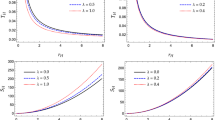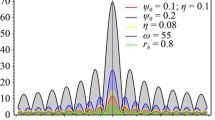Abstract
It has recently been shown by Yang et al. (Phys Rev D 87:041502(R), 2013a; Phys Rev D 88:044047, 2013b) that rotating Kerr black holes are characterized by two distinct sets of quasinormal resonances. These two families of quasinormal resonances display qualitatively different asymptotic behaviors in the extremal (\(a/M\rightarrow 1\)) black-hole limit: the zero-damping modes are characterized by relaxation times which tend to infinity in the extremal black-hole limit (\(\mathfrak {I}\omega \rightarrow 0\) as \(a/M\rightarrow 1\)), whereas the damped modes (DMs) are characterized by non-zero damping rates (\(\mathfrak {I}\omega \rightarrow \) finite-values as \(a/M\rightarrow 1\)). In this paper we refute the claim made by Yang et al. that co-rotating DMs of near-extremal black holes are restricted to the limited range \(0\le \mu \lesssim \mu _{\text {c}}\approx 0.74\), where \(\mu \equiv m/l\) is the dimensionless ratio between the azimuthal harmonic index m and the spheroidal harmonic index l of the perturbation mode. In particular, we use an analytical formula originally derived by Detweiler in order to prove the existence of DMs (damped quasinormal resonances which are characterized by finite \(\mathfrak {I}\omega \) values in the \(a/M\rightarrow 1\) limit) of near-extremal black holes in the \(\mu >\mu _{\text {c}}\) regime, the regime which was claimed by Yang et al. not to contain DMs. We show that these co-rotating DMs (in the regime \(\mu >\mu _{\text {c}}\)) are expected to characterize the resonance spectra of rapidly rotating (near-extremal) black holes with \(a/M\gtrsim 1-10^{-9}\).
Similar content being viewed by others
Avoid common mistakes on your manuscript.
1 Introduction
Perturbed black holes display a unique pattern of damped oscillations, known as quasinormal resonances, which characterize the relaxation phase of the black-hole spacetime. The spectrum of the quasinormal resonances reflects the physical parameters (such as mass, charge, and angular momentum) of the black-hole spacetime.
The complex quasinormal resonances correspond to perturbation fields which propagate in the black-hole spacetime with the physically motivated boundary conditions of purely outgoing waves at spatial infinity and purely ingoing waves crossing the black-hole horizon [1]. These boundary conditions single out a discrete set, \(\{\omega ^{\text {QNM}}(n;m,l)\}_{n=0}^{n=\infty }\), of complex black-hole resonances for each perturbation mode (here m and l are the azimuthal harmonic index and the spheroidal harmonic index of the wave field, respectively).
In a very interesting paper, Yang et al. [2, 3] have recently studied numerically the quasinormal spectrum of near-extremal (rapidly rotating) Kerr black holes. The authors of [2, 3] have reached the remarkable conclusion that these rapidly rotating black holes are characterized by two qualitatively distinct sets of quasinormal resonances:
-
Zero-damping modes (ZDMs), which are characterized by the asymptotic property (for these unique black-hole resonances, see: [4–7])
$$\begin{aligned} \mathfrak {I}\omega ^{\text {ZDM}}(\tau \rightarrow 0)\rightarrow 0, \end{aligned}$$(1)and
-
Damped modes (DMs), which are characterized by the asymptotic property
$$\begin{aligned} \mathfrak {I}\omega ^{\text {DM}}(\tau \rightarrow 0)\rightarrow {\text {finite values}}. \end{aligned}$$(2)
Here
is the dimensionless Bekenstein–Hawking temperature of the black hole (The Bekenstein–Hawking temperatures of Kerr black holes are given by the relation \(T_{\text {BH}}=\tau /8\pi M\). We shall use units in which \(G=c=\hbar =1\)), where \(r_{\pm }\equiv M\pm (M^2-a^2)^{1/2}\) are the black-hole (event and inner) horizons. This dimensionless temperature approaches zero in the extremal \(a\rightarrow M\) (\(r_-\rightarrow r_+\)) limit of rapidly rotating black holes.
2 The erroneous claim made in [2] and Detweiler’s damped resonances
It has been asserted in Ref. [2, 3] that the ZDMs (1) exist for all co-rotating modes (\(m\ge 0\)) (for these unique black-hole resonances, see: [4–7]), whereas the DMs (2) exist for counter-rotating modes (\(m<0\)) and for co-rotating modes in the limited range
Here
is the dimensionless ratio between the azimuthal harmonic index m and the spheroidal harmonic index l of the perturbation mode. The critical ratio, \(\mu _{\text {c}}\), is given by \(\mu _{\text {c}}=\sqrt{{{15-\sqrt{193}}\over {2}}}\simeq 0.74\) in the eikonal limit [2, 3, 8]. This critical value of the dimensionless ratio \(\mu \) marks the boundary between perturbations modes (those with \(\mu \le \mu _{\text {c}}\)) which are characterized by imaginary values of the angular-eigenvalue \(\delta \). [the parameter \(\delta ^2\) is closely related to the angular-eigenvalue of the angular Teukolsky equation, see [9] for details (see, in particular, equations (2.7) and (6.3) of [9])] and perturbations modes (those with \(\mu >\mu _{\text {c}}\)) which are characterized by real values of the angular-eigenvalue \(\delta \).
Here we would like to point out that the assertion made in Ref. [2, 3], according to which co-rotating DMs exist only in the limited range \(0\le \mu \lesssim \mu _{\text {c}}\) [see Eqs. (2), (4)], is actually erroneous. In particular, we shall show that co-rotating DMs of near-extremal black holes [see Eq. (10) below] actually exist in the entire range
In fact, Detweiler [10] has obtained an analytic expression for co-rotating DMs of near-extremal black holes which is valid in the regime \(\mu >\mu _{\text {c}}\) (that is, as shown in [10], the expression (7) is valid for co-rotating modes with real \(\delta \) eigenvalues):
where \(\Omega _{\text {H}}\equiv a/2Mr_+\) is the angular-velocity of the black-hole horizon, and the integer n is the resonance parameter of the mode. Here we have used the definitions [10]
It is worth emphasizing again that Eq. (7), originally derived in [10], describes DMs in the \(\mu >\mu _{\text {c}}\) (\(\delta ^2>0\)) regime, the regime which was claimed in [2, 3] not to contain DMs.
3 The source of the erroneous claim made in [2]
It is important to understand the reason for the failure of Yang et. al. [2, 3] to observe the DMs (7) of [10] in the regime \(\mu >\mu _{\text {c}}\) (the failure in [2, 3] to observe these resonances numerically is probably the reason behind the erroneous claim (see Eq. (4)) made in [2, 3]). In order to understand the null result of [2, 3] in finding numerically the DMs (7), one should examine the regime of validity of the analyzes presented in [9, 10].
A careful check of these analyzes reveals that the expression (7) for the black-hole DMs [10] is valid in the regime
where the dimensionless coordinate \(x\equiv (r-r_+)/r_+\) belongs to an overlapping region in which two different expressions for the radial Teukolsky wave function (hypergeometric and confluent hypergeometric functions) can be matched; see [9, 10] for details. Taking cognizance of the inequalities in (9), one realizes that the expression (7) for co-rotating DMs with \(\mu >\mu _{\text {c}}\) is only valid in the regime of near-extremal (rapidly rotating) black holes.
In particular, since each inequality sign in (9) roughly corresponds to an order-of-magnitude difference between two variables (that is, \(\tau /\varpi \lesssim 10^{-1}\), \(\varpi /x\lesssim 10^{-1}\), and \(x\lesssim 10^{-1}\)), the expression (7) for the black-hole DMs [10] is not expected to be valid outside the regime (in order to be on the safe side, we have added an extra order of magnitude to the inequality (10))
The inequality (10) corresponds to rapidly rotating black holes with [see Eq. (3)]
It is worth noting that the numerical analysis presented in [2, 3] did not explore the deep near-extremal regime (11) of the rotating Kerr black holes. A. Zimmerman (private communication) has kindly updated me that he has not detected in his numerical studies DMs in the regime \(\mu >\mu _{\text {c}}\) for a rapidly-rotating Kerr black hole with \(a/M = 1 - 10^{-9}\). As a consequence, the co-rotating DMs (7) in the regime \(\mu >\mu _{\text {c}}\) have not been observed in the numerical study of [2, 3]. This simple fact has probably led Yang et al. [2, 3] to the erroneous conclusion that co-rotating DMs are restricted to the limited range  .
.
4 Summary
It is well known that rapidly rotating (near-extremal) black holes are characterized by two qualitatively distinct sets of quasinormal resonances: (1) zero-damping modes (ZDMs), which are characterized by the asymptotic property (for these unique black-hole resonances, see: [4–7]) \(\mathfrak {I}\omega ^{\text {ZDM}}(\tau \rightarrow 0)\rightarrow 0\), and (2) damped modes (DMs), which are characterized by the asymptotic property \(\mathfrak {I}\omega ^{\text {DM}}(\tau \rightarrow 0)\rightarrow {\text {finite values}}\).
In this comment we have refuted the claim made in Ref. [2, 3] that co-rotating DMs of near-extremal black holes are restricted to the limited range \(0\le \mu \lesssim \mu _{\text {c}}\) [see Eqs. (2), (4)]. In particular, we have pointed out that the analytical expression (7), originally derived in [10], describes DMs in the \(\mu >\mu _{\text {c}}\) regime (that is, as shown in [10], the expression (7) is valid for co-rotating modes with real \(\delta \) eigenvalues), the regime which was claimed in [2, 3] not to contain DMs.
Most importantly, we have emphasized the fact that the analytical expression (7) for the black-hole DMs is not expected to be valid outside the deep near-extremal regime (11) of rapidly rotating black holes.
Finally, it is worth emphasizing that rapidly rotating black holes in the regime (11) are probably of no astrophysical relevance [11]. However, these near-extremal black holes are very important from the point of view of quantum field theory. In particular, these black holes play a key role in the conjectured relation between the quantum states of near-extremal black holes and the corresponding quantum states of a two-dimensional conformal field theory [12–14] (For the physical relevance of these near-extremal black holes to the conjectured universal relaxation bound, see [4–7] and also [15–17]).
References
S.L. Detweiler, in Sources of Gravitational Radiation, ed. by L. Smarr (Cambridge University Press, Cambridge, 1979)
H. Yang, F. Zhang, A. Zimmerman, D.A. Nichols, E. Berti, Y. Chen, Phys. Rev. D 87, 041502(R) (2013a)
H. Yang, A. Zimmerman, A. Zenginoglu, F. Zhang, E. Berti, Y. Chen, Phys. Rev. D 88, 044047 (2013b)
S. Hod, Phys. Rev. D 75, 064013 (2007). arXiv:gr-qc/0611004
S. Hod, Class. Quant. Grav. 24, 4235 (2007).arXiv:0705.2306
S. Hod, Phys. Rev. D 78, 084035 (2008).arXiv:0811.3806
S. Hod, Phys. Rev. D 80, 064004 (2009).arXiv:0909.0314
S. Hod, Phys. Lett. B 715, 348 (2012).arXiv:1207.5282
S.A. Teukolsky, W.H. Press, Astrophys. J. 193, 443 (1974)
S. Detweiler, Astrophys. J. 239, 292 (1980)
K.S. Thorne, Astrophys. J. 191, 507 (1974)
J.M. Bardeen, G.T. Horowitz, Phys. Rev. D 60, 104030 (1999)
M. Guica, T. Hartman, W. Song, A. Strominger, Phys. Rev. D 80, 124008 (2009)
A. Strominger, C. Vafa, Phys. Lett. B 379, 99 (1996)
A. Gruzinov. arXiv:0705.1725 [gr-qc]
A. Pesci, Class. Quantum Grav. 24, 6219 (2007)
S. Hod, Phys. Lett. B 666, 483 (2008).arXiv:0810.5419
Acknowledgments
This research is supported by the Carmel Science Foundation. I would like to thank Aaron Zimmerman for interesting correspondence. I would also like to thank Yael Oren, Arbel M. Ongo, Ayelet B. Lata, and Alona B. Tea for stimulating discussions.
Author information
Authors and Affiliations
Corresponding author
Rights and permissions
Open Access This article is distributed under the terms of the Creative Commons Attribution 4.0 International License (http://creativecommons.org/licenses/by/4.0/), which permits unrestricted use, distribution, and reproduction in any medium, provided you give appropriate credit to the original author(s) and the source, provide a link to the Creative Commons license, and indicate if changes were made.
Funded by SCOAP3.
About this article
Cite this article
Hod, S. On the branching of the quasinormal resonances of near-extremal Kerr black holes. Eur. Phys. J. C 75, 520 (2015). https://doi.org/10.1140/epjc/s10052-015-3747-4
Received:
Accepted:
Published:
DOI: https://doi.org/10.1140/epjc/s10052-015-3747-4




